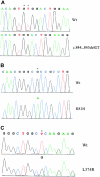Cold-induced sweating syndrome is caused by mutations in the CRLF1 gene
- PMID: 12509788
- PMCID: PMC379230
- DOI: 10.1086/346120
Cold-induced sweating syndrome is caused by mutations in the CRLF1 gene
Abstract
In 1978, Sohar et al. described a strikingly peculiar syndrome in two Israeli sisters. These young women responded to environmental temperatures of 18 degrees C-7 degrees C with profuse sweating on large segments on their back and chest. Both had additional abnormalities, including a high-arched palate, nasal voice, depressed nasal bridge, inability to fully extend their elbows, and kyphoscoliosis. We have observed this disorder in two Norwegian brothers. Genome-wide screening in the two families, followed by saturation marker studies and linkage analysis, identified a 1.4-Mb homozygous candidate region on chromosome 19p12. The maximum multipoint LOD score was 4.22. In both families, DNA sequencing of 25 genes within the candidate region identified potentially deleterious CRLF1 sequence variants that were not found in unaffected control individuals. Our findings confirm that the cold-induced sweating syndrome is an autosomal recessive disorder that is probably caused by impaired function of the CRLF1 gene, and they suggest important developmental functions for human CRLF1.
Figures


Similar articles
-
Crisponi syndrome is caused by mutations in the CRLF1 gene and is allelic to cold-induced sweating syndrome type 1.Am J Hum Genet. 2007 May;80(5):971-81. doi: 10.1086/516843. Epub 2007 Mar 30. Am J Hum Genet. 2007. PMID: 17436252 Free PMC article.
-
Cold-induced sweating syndrome: a report of two cases and demonstration of genetic heterogeneity.J Neurol Sci. 2006 Dec 1;250(1-2):62-70. doi: 10.1016/j.jns.2006.07.001. Epub 2006 Sep 6. J Neurol Sci. 2006. PMID: 16952376
-
Cold-induced sweating syndrome with neonatal features of Crisponi syndrome: longitudinal observation of a patient homozygous for a CRLF1 mutation.Am J Med Genet A. 2010 Mar;152A(3):764-9. doi: 10.1002/ajmg.a.33315. Am J Med Genet A. 2010. PMID: 20186812
-
A new case series of Crisponi syndrome in a Turkish family and review of the literature.Clin Dysmorphol. 2017 Apr;26(2):66-72. doi: 10.1097/MCD.0000000000000163. Clin Dysmorphol. 2017. PMID: 27977424 Review.
-
Crisponi/cold-induced sweating syndrome: Differential diagnosis, pathogenesis and treatment concepts.Clin Genet. 2020 Jan;97(1):209-221. doi: 10.1111/cge.13639. Epub 2019 Sep 16. Clin Genet. 2020. PMID: 31497877 Review.
Cited by
-
Effect of human very low-density lipoproteins on cardiotrophin-like cytokine factor 1 (CLCF1) activity.Sci Rep. 2018 Mar 5;8(1):3990. doi: 10.1038/s41598-018-22400-y. Sci Rep. 2018. PMID: 29507344 Free PMC article.
-
Speeding up HMM algorithms for genetic linkage analysis via chain reductions of the state space.Bioinformatics. 2009 Jun 15;25(12):i196-203. doi: 10.1093/bioinformatics/btp224. Bioinformatics. 2009. PMID: 19477987 Free PMC article.
-
CRLF1 promotes malignant phenotypes of papillary thyroid carcinoma by activating the MAPK/ERK and PI3K/AKT pathways.Cell Death Dis. 2018 Mar 7;9(3):371. doi: 10.1038/s41419-018-0352-0. Cell Death Dis. 2018. PMID: 29515111 Free PMC article.
-
Crisponi syndrome is caused by mutations in the CRLF1 gene and is allelic to cold-induced sweating syndrome type 1.Am J Hum Genet. 2007 May;80(5):971-81. doi: 10.1086/516843. Epub 2007 Mar 30. Am J Hum Genet. 2007. PMID: 17436252 Free PMC article.
-
Cold induced sweating syndrome with urinary system anomaly association.Case Rep Pediatr. 2013;2013:173890. doi: 10.1155/2013/173890. Epub 2013 Aug 29. Case Rep Pediatr. 2013. PMID: 24073352 Free PMC article.
References
Electronic-Database Information
-
- Center for Medical Genetics, Marshfield Medical Research Foundation, http://www.marshfieldclinic.org/research/genetics/
-
- Cooperative Human Linkage Center, The, http://gai.nci.nih.gov/CHLC/
-
- Entrez Genome, http://www.ncbi.nlm.nih.gov/mapview/map_search.cgi? (for NCBI Map Viewer, build 30)
-
- GenBank, http://www.ncbi.nlm.nih.gov/Genbank/ (for CRLF1 cDNA [accession number NM_004750.2])
References
-
- Alexander WS, Rakar S, Robb L, Farley A, Willson TA, Zhang JG, Hartley L, Kikuchi Y, Kojima T, Nomura H, Hasegawa M, Maeda M, Fabri L, Jachno K, Nash A, Metcalf D, Nicola NA, Hilton DJ (1999) Suckling defect in mice lacking the soluble haemopoietin receptor NR6. Curr Biol 9:605–608 - PubMed
-
- Cobb JR (1948) Outline for the study of scoliosis. American Academy of Orthopedic Surgeons Instructional Course Lectures 5:261–265
-
- Davis S, Aldrich TH, Valenzuela DM, Wong VV, Furth ME, Squinto SP, Yancopoulos GD (1991) The receptor for ciliary neurotrophic factor. Science 253:59–63 - PubMed
Publication types
MeSH terms
Substances
Grants and funding
LinkOut - more resources
Full Text Sources
Medical
Molecular Biology Databases
Miscellaneous

